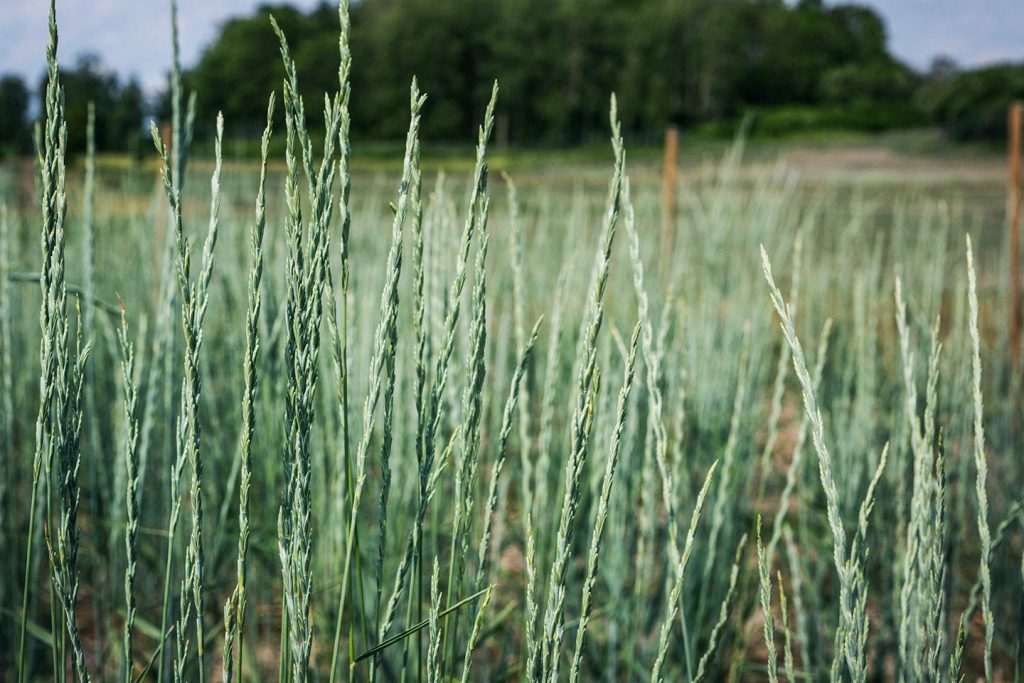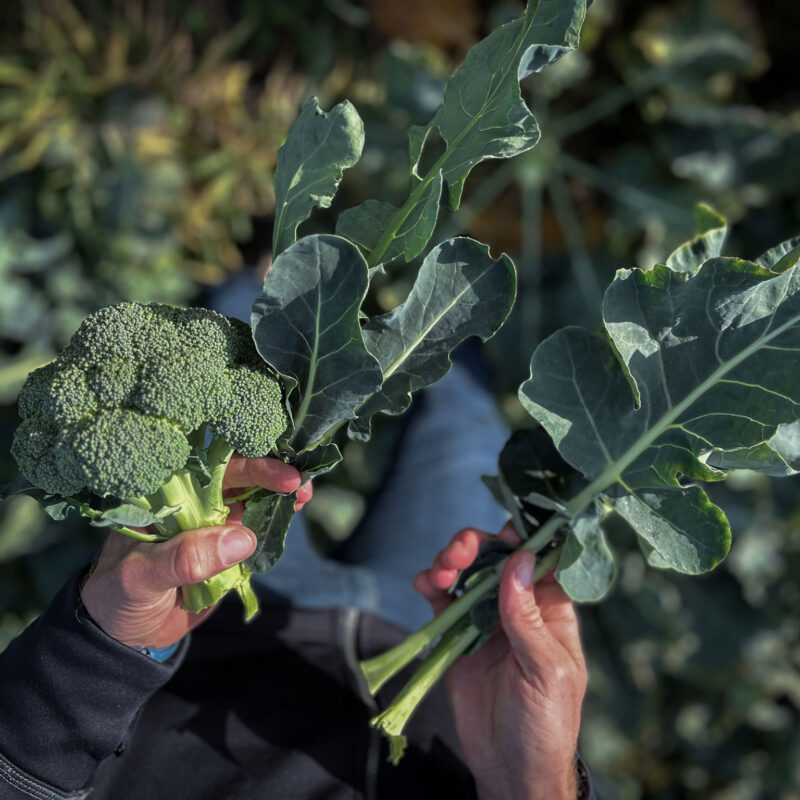Perennial Wheat – An Agricultural Revolution
Most of the problems that farming is struggling with – large emissions of greenhouse gases, soil erosion, nutrient run-off, and overuse of chemicals – could be solved if perennial grains were grown instead of annuals. To contribute to this shift, Axfoundation is collaborating with the Swedish University of Agricultural Sciences (SLU) in their ground-breaking research at Torsåker Farm, where perennial relatives of wheat and barley are used in the breeding of perennial grains. The genetic material comes from three unique plant-breeding programs, one of them is The Land Institute which has developed the perennial wheat Kernza®.

Perennial wheat can store more carbon in roots and soil than their annual relatives, which may result in a reduction in greenhouse gas emissions and mitigation of climate change.
The Issue
Crops have been improved through breeding for hundreds of years with such a strong focus on high yields that they have lost properties that now are important for adapting to climate change. This makes the food systems of the future vulnerable. All cereal grains grown today in temperate climates are annual. This means that they are planted and harvested all in one year, and this is repeated the next year. In an annual cropping system, the farmers plow the soil regularly which can lead to nutrient losses, erosion, decreased soil quality, and release of greenhouse gases.
Our Solution
Perennial crops, with the ability to grow year after year without replanting or annual plowing, could make a valuable addition to sustainable agriculture. With their deep and well-developed root systems, present all year round, perennial crops protect the soil from erosion and nutrient leakage. Among the core benefits are also their ability to use the full long growing season for carbon uptake for photosynthesis and growth, and the storage of carbon in roots and soil, which may result in a reduction in greenhouse gas emissions and mitigation of climate change.
The cultivation of perennial cereals is still in an early stage. Therefore, they are not grown on a large scale. For example, the yields are still lower compared to annual crops. To develop the crops and address the challenges, several plant breeding programs are ongoing. At Torsåker Farm, Axfoundation’s test farm and development center for the sustainable food systems of the future, populations of perennial wheat with significant genetic variation from three different plant breeding programs are currently being tested.
Perennial wheat at Torsåker Farm has been produced by the domestication of a perennial relative to wheat, (Thinopyrum intermedium). The initial work was done by plant breeders at the Rodale Institute in Pennsylvania, USA. Since 2003, researchers at The Land Institute in Kansas, led by Dr. Lee DeHaan, have further developed a perennial wheat; Kernza®. By choosing the best plants based on for example number of seeds, seed size and other harvest traits, improved populations have been achieved.

Torsåker Farm hosts genetic material from three different plant breeding programs.

Anna Westerbergh (SLU) is the scientific leader of the perennial grain crop breeding at Torsåker Farm.
Our Work
Axfoundation supports the efforts to develop perennial grains with the potential to revolutionize agriculture. Torsåker Farm has been established as a long-term field site for perennial grains, such as intermediate wheatgrass. The plant breeding program is run by the Swedish University of Agricultural Sciences (SLU) and the researcher in charge is Anna Westerbergh, senior fellow in genetics and plant breeding at the Institution for Plant Biology at SLU. The project is also the first in the world to domesticate and plant breed a perennial relative of barley, “Bulbous Barley”, into a perennial barley grain.
The goal is to improve the grains’ agronomic traits, enhance the yield and adapt the plants to thrive in the northern and mid-European climates. The plant breeding program focuses on desirable attributes such as high and consistent seed yield, synchronous flowering and seed maturation, and seed retention, also called non-shattering. Large, diverse populations of the crop are grown out at Torsåker Farm, and plant breeders select the best individuals for the traits of interest. These individual plants are then cross-pollinated, and the resulting seeds are planted to produce the next improved breeding population.
The genetic material for the perennial relative of wheat comes from three unique plant-breeding programs: The Rodale Institute in Pennsylvania (USA), The Land Institute in Kansas (USA) which has developed the perennial wheat Kernza®, and the University of Manitoba (Canada). To date, the cultivation program at Torsåker Farm is the only one outside North America, based on genetic diversity from all three breeding programs and carried out during different climate conditions.
Results
Developing new crops takes time, even years. A large genetic variation of plants with different geographical origins is evaluated and the best plants are selected and crossed over several plant generations. Being able to study plants at a location over an extended period is essential, and the groundbreaking research at Torsåker Farm has proven to be successful.
Between 2018 and 2019, the number of intermediate wheatgrass plants planted at Torsåker Farm ten-folded from 3,000 to 30,000. In 2020, based on extensive data from the plants established in 2018, the first selection of the best parent plants of intermediate wheatgrass was made. The plants were cloned and planted out in trials at three separate locations at Torsåker Farm for further evaluation and seed production.
In the fall of 2021, 2022 and 2023, an early variant of this perennial relative of wheat was harvested on half a hectare of land. This was an important step that showed that it is possible to thresh the intermediate wheatgrass with a standard combine harvester, currently used in grain cultivation. Axfoundation is now investigating the possibility of scaling up to enable the production of this intermediate wheatgrass as a seed for Swedish farmers.
Part of Axfoundation’s contribution is to identify the commercial potential for the crop in collaboration with chefs and bakers. At Torsåker Farm, pizzas baked with flour from the perennial relative of wheat are continuously served to highlight the issues of sustainable agriculture.

The perennial intermediate wheatgrass has a deeper root system compared to the annual wheat.
From idea to harvest at Torsåker Farm
2013
- Axfoundation visits The Land Institute and an idea of perennial wheat suited to the Nordic climate begins to sprout.
2018
- The research project on intermediate wheatgrass at Torsåker Farm is initiated together with Anna Westerbergh at SLU, and tenant farmer Mats Eriksson at Sättra Farm.
- Planting of 3,000 seedlings of intermediate wheatgrass to study important traits.
2019
- An additional 30,000 seedlings of intermediate wheatgrass are planted. The planting is done in a detailed grid system to study growth, harvest and intercropping with legumes.
- Axfoundation participates in and supports an international research meeting in Lund in collaboration with The Land Institute.
- Guests at Human Nature 2019 taste wafer baked with Kernza flour.
2020
- Plants performing particularly well under Swedish conditions are cloned and 1,200 plants are planted for further evaluation and selection at Torsåker Farm.
- With the support from Axfoundation, The Land Institute won the Food Planet Prize 2020 for its work for sustainable agriculture. The prize money contributed to starting the The Land Institute International Initiative, a global collaboration for the development of perennial crops, where Sweden is an important hub.
2021
- The first threshing of intermediate wheatgrass at Torsåker Farm. About 0.5 ha is threshed using a standard combine.
- Results and overview of the perennial grain breeding are presented at the UN Food System Summit by Anna Westerbergh, senior fellow in genetics and plant breeding at the institution for plant biology at SLU.
- The Land Institute visits Torsåker Farm to see how the experiments develop under Swedish conditions.
2022
- Pizzas baked with flour from intermediate wheatgrass are served at an event at Torsåker Farm.
- Two early varieties of this perennial relative of annual wheat are sown with a regular row drilling machine in an open field test plot.
- The next generation of 1,700 seedlings from selected parents is planted.
- Wasabröd joins as a financing partner for the research on genomic selection, a new method for efficient breeding.
2023
- The annual phenotypic studies, where researchers examine crop yield characteristics, kernel size, straw height, and more, are conducted on 1200 plants.
- Axfoundation and SLU (The Swedish University of Agricultural Sciences) participate in the KernzaCon conference, where researchers from around the world exchange experiences regarding perennial crops. Anna Westerberg presents the crop cultivation experiment at Torsåker Farm and gains valuable insights for the project’s future development.
2024
- The commercial potential of intermediate wheatgrass is investigated.
Partners
Swedish University of Agricultural Sciences (SLU), The Land Institute, Wasabröd
The research on genomic selection is partially financed by Wasabröd with the ambition to speed up the plant breeding of perennial wheat for Nordic conditions.
Interested in knowing more about Anna Westerbergh – don’t miss the interview on Kernza®!






















































